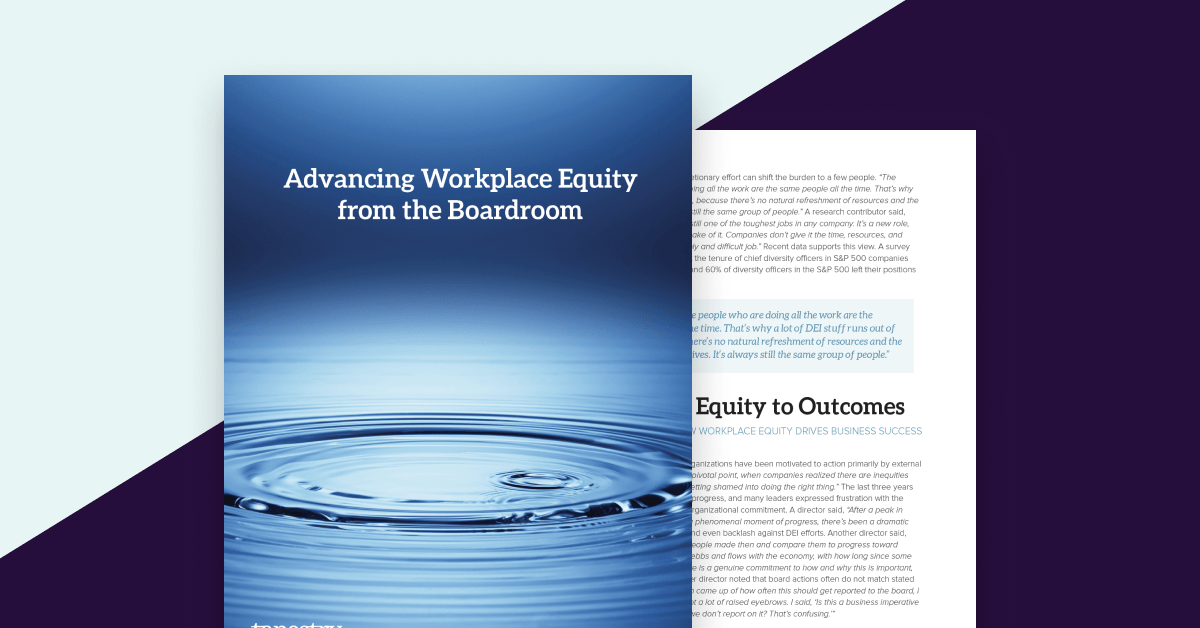Corporate boards play a critical role in advancing workplace equity, responding to the collective demand from investors, regulators, employees, and stakeholders to promote fair pay, diversity, and opportunity equity. As stewards of responsible business governance, boards can drive organizational commitment to workplace equity and provide essential guidance to management teams.
However, while wielding significant influence, many boards are still developing their capacity to effectively oversee workplace equity, often facing challenges due to the lack of rigor around data analysis, metrics, and targets — all of which results in an elusive understanding of progress and measurable impact.
To unlock the true potential of workplace equity initiatives, boards must embrace and push for data-driven strategies. To address this imperative, Tapestry Networks, in collaboration with Syndio’s Fair Pay Workplace, conducted a study on Advancing Workplace Equity from the Boardroom.
Below, we share key insights from the report and present five data-driven strategies that boards can adopt to improve oversight of workplace equity programs and accelerate workplace equity.
1. Push for a unified vocabulary and definitions for workplace equity terms and goals.
A common challenge holding back board oversight around workplace equity is a lack of shared understanding around related concepts and objectives. Stakeholders may use a variety of similar-but-different terms such as “workplace equity,” “diversity” “DE&I”, “DEI&B”, “fair pay,” “pay equity”, “pay gap”, “representation,” “antiracism,” and “opportunity equity”, which can potentially lead to confusion and misalignment.
Developing a shared vocabulary with standard definitions can empower boards and leadership teams to more effectively evaluate their organization’s current workplace equity status, set clear diversity and equity goals and strategies, and accurately measure progress toward achieving them.
2. Ensure that boards receive robust and actionable people data.
HR reporting to boards all-too-often starts and ends with employee engagement survey results. Boards should push to receive a more robust range of hard metrics around people data that can indicate progress over time for pay equity, diversity, and opportunity equity, including regular reporting on:
-
- Representation: HR leaders should provide a high-level view of the workforce composition based on demographic data, such as the gender ratio or race/ethnicity breakdown within various teams and levels. This analysis can help boards gauge diversity and inclusivity throughout the organization, as well as justifying employee programs and benefits in terms of attracting job candidates and retaining talent.
- Promotion rates: Pay gaps are exacerbated by inequitable promotion rates, as they result in specific groups being excluded from career advancements that lead to higher pay. Promotion gap analysis can highlight areas of high impact on pay gaps, such as resource allocation and targeted talent development in specific departments.
- Attrition rates: Disparities in attrition rates can signal underlying culture issues and a lack of inclusion, belonging, and support that leads certain groups to leave at higher rates. Even with equitable hiring and promotions, unequal retention may result in representation and pay gaps. Investigating the reasons behind certain groups’ inequitable retention rates enables targeted investments for improving inclusivity and belonging.
- Pay equity / pay gap: To tell the full story of the company’s pay gaps, HR leaders should report on both pay equity (i.e. “equal pay for equal work”) and unadjusted pay gaps (i.e. the overall difference in earnings between two populations, without accounting for measurable factors such as tenure or years of experience).
- Benchmarking: To meaningfully understand where representation stands, it’s essential to compare to both internal benchmarks as well as to competitors and your industry and/or geography.
Board should push HR leaders to get granular with data reporting at the board level — for example, breaking out specific BIPOC groups rather than lumping them all together, which can obscure inequities. Boards should also be interested to see analysis data for factors beyond race and gender, such as age, disability, LGBTQ+ identity, or veteran status, as well as intersections.
Boards should also push HR leaders to go deeper in the data: level-setting on the company’s current standing in comparison to established benchmarks, analyzing trends over time, flagging root causes of inequities, and accurately forecasting milestones for goal achievements. Investment in workplace equity analytics software can empower HR leaders to analyze and report on all these critical aspects to their board.
3. Tie workplace equity efforts directly to concrete business objectives.
In the face of vague reporting and ambiguous targets, workplace equity and DE&I continue to be viewed as a cost center by many leaders and organizations, rather than a contributor to business performance. This leads to workplace equity programs struggling for resources and attention.
Conversations around workplace equity need to be reframed in terms of business impact and differentiation, which requires clearly connecting the dots through data between investments and business performance. Boards should ask to see concrete links between specific workplace equity efforts and outcomes such as talent resilience, innovation, and risk mitigation.
4. Establish realistic, quantitative goals for workplace equity initiatives to enhance accountability.
According to HR analyst Josh Bersin, about 80% of companies are “just going through the motions” of DE&I and “not holding themselves accountable.” Goals that have vague or overly-extended timelines lack accountability. Data is crucial for creating achievable targets with realistic timelines. Boards should expect HR leaders to establish quantitative, measurable objectives for workplace equity programs.
Syndio’s OppEQ® solution can forecast progress towards diversity goals based on expected growth, attrition, and promotion rates. It also allows organizations to model scenarios to understand the impact on diversity trajectories to make the case for specific policies or focus areas that would accelerate progress.
5. Push HR leaders to deliver people data in a relevant, compelling way.
More information isn’t always more meaningful, if it can’t be assessed meaningfully. Boards should encourage HR leaders to parse the data and highlight key insights that are most crucial to board oversight and decision-making. Trends are more helpful than snapshots, as is coming armed with root cause analysis data rather than simply pointing out a problem.
It’s important for the data to drive a narrative around where the greatest gaps lie and the greatest areas of opportunity to accelerate progress. What story does the data reveal and what is the key takeaway for the board’s decision-making?
From insights to impact
By empowering HR leaders to embrace data analytics, set measurable goals, and reframe workplace equity efforts as business imperatives, boards can empower organizations to accelerate progress towards a more equitable workplace.
To learn more, read the full report on Advancing Workplace Equity from the Boardroom linked below.
The information provided herein does not, and is not intended to, constitute legal advice. All information, content, and materials are provided for general informational purposes only. The links to third-party or government websites are offered for the convenience of the reader; Syndio is not responsible for the contents on linked pages.


